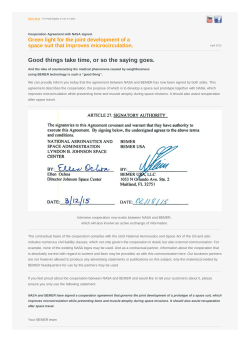
SOB "HOW TO" Guide 1
Software-On-Board "How To" Guide 1 SOB "HOW TO" Guide 1 Connect the NASA AIS Receiver to your PC The NASA AIS Engine allows real-time tracking of AIS equipped ships on SOB’s chart display screen. Size 115mm x 100mm x 30mm Power 43 mA Connections: 12V DC, VHF Antenna (BNC), PC Serial (9-pin "D") Baud Rate: 38400 NMEA Sentences Output: VDM for ITU messages 1,2,3,4,5,11,18,19 & 21 RMC Relayed from an optional GPS PNMLS Proprietary NASA Marine sentence Full Specifications: www.digiboat.com.au/sales_products_sob.htm#ais Manufacturer's website: www.nasamarine.com Wiring the NASA AIS Device The NASA requires three separate connections: power, aerial and computer… Power The NASA device requires 12V DC power supply. So will directly connect to an automotive or marine battery, and to any ship's 12V supply. For home (shore-based) use, any 12VDC consumer-type transformer (as used for a cassette/radio and various other devices). The transformer must output at least 100 or 200mA. Carefully observe the polarity if butchering into an existing transformer. Connect the NASA Red wire (fused) to the POSITIVE side of the power supply and the Red/Black wire to the power's NEGATIVE or GROUND or EARTH connection. Aerial The NASA AIS Receiver requires a standard VHF antenna for receiving the messages sent from ships with AIS transponders. Ideally the NASA requires its own dedicated antenna, although it is possible to share an antenna with your VHF radio by using an electronic switcher – pictured right. Note: AIS Targets will not be received while the VHF radio is transmitting. In the USA, the VHF Antenna Splitter is available from: http://www.milltechmarine.com/products.htm The NASA aerial connection is a small BNC coax bayonet-type, whereas the regular VHF radio and marine VHF antenna connections are standardized to the large PL259 screw-type connection. You may need to use a PL259-to-BNC Adaptor between the aerial and the NASA. Note: we recommend an alternate approach to the one-piece adaptor pictured at left – a short coax strop with the PL259 at one end and BNC at the other (as used in the Splitter above). Using the one-piece adaptor (pictured) will place a lot of stress on the physical connection inside the NASA housing. 25 Jun 2007 www.digiboat.com.au Software-On-Board "How To" Guide 2 Serial Connection to the Computer The NASA is supplied with a standard 9-pin serial cable (black). The end with the loose blue wire connects to the NASA box and the other end to the 9-pin serial "D" plug on the computer. Note: Most new computers do not have a compatible serial plug to connect to. In this case, you require a separate device, a "USB to Serial Converter". Visit our webshop: www.digiboat.com.au/sales_products_sob.htm#usb-com for dual and quad serial versions, or purchase a single from your local electronics supply store. The NASA can pass-through a GPS signal allowing the NASA and a GPS to share a single connection (COM Port) on the computer (the GPS data will be merged with the AIS data). The NASA device itself does not need a GPS connected in order to work. Observe the photographs of the different wiring methods with or without a GPS pass-thru: Option 1: Use this picture for help connecting a GPS to "passthru" the NASA Engine. The GPS must be set for WGS84 and NMEA output at 4800 baud (consult your GPS manual). The black NASA serial (9-pin "D") plug connects directly to a matching socket on your computer. See Note above. Option 2: If not using the GPS pass-thru then simply connect the AIS black plug to the computer. See Note above. 25 Jun 2007 www.digiboat.com.au Software-On-Board "How To" Guide 3 Configure SOB to connect to the NASA To complete the connection SOB must be told which serial COM port the NASA is connected to. The steps depend if the NASA is plugged straight into the computer serial port or connected via a USB to Serial Converter: Serial port Double-click the chart (anywhere) in SOB to open the Raw NMEA Data form. Make the pictured settings which will work in most cases. The AIS requires 38400 baud. Most other NMEA devices use 4800. Set to AutoPort will open the next COM port that is found, starting at COM2. USB port When connected through a USB to Serial Converter, the driver that was supplied with the Converter must be installed first. This creates a "virtual" COM port to which SOB connects. Run the SOB_PORTS program by pressing the [Identify PORTS] button (circled blue above). Identify the COM port created by the driver. Highlight it then press the [Add>>] button and set the baud to 38400 and [Save & Exit] 25 Jun 2007 Each make of driver is named differently. Below are 3 typical examples. If in doubt, pull out the USB plug from the computer and press the [Refresh] button (top-left) and see which is missing, then reconnect it and press refresh again. www.digiboat.com.au Software-On-Board "How To" Guide 4 Successful Connections The NASA AIS must be in a position within VHF range of AIS transponding ships. If the NASA is receiving transmissions, and SOB is correctly configured, you will see the following example data sentences received from the NASA and displayed on SOB's Raw NMEA Data form: The NASA NMEA sentence '$PNMLS' always follows an AIS message if a GPS pass-thru is not used. It represents the threshold value (eg, 24) and the signal strength of the received AIS message. For electronics enthusiasts, we have devised a way to connect indicating LEDs to the NASA to show power-on and various movements of the NMEA data. Refer to this webpage for complete instructions: http://www.digiboat.com.au/NASA_DIY_LED.htm end 25 Jun 2007 www.digiboat.com.au
© Copyright 2025





















